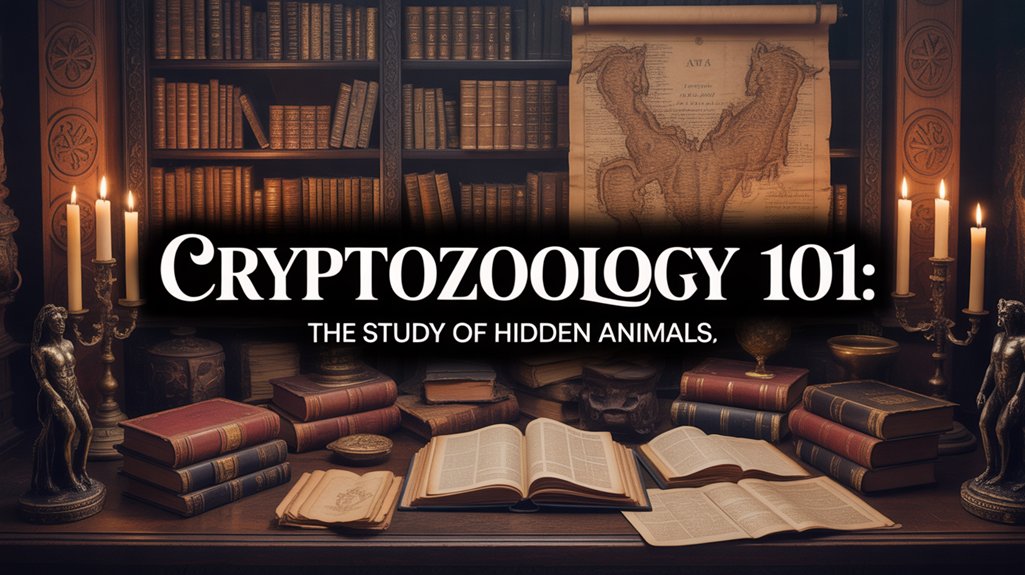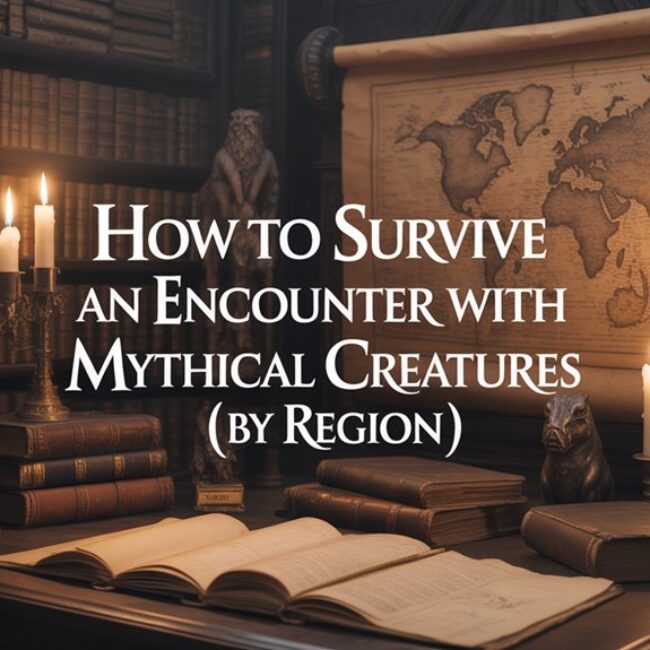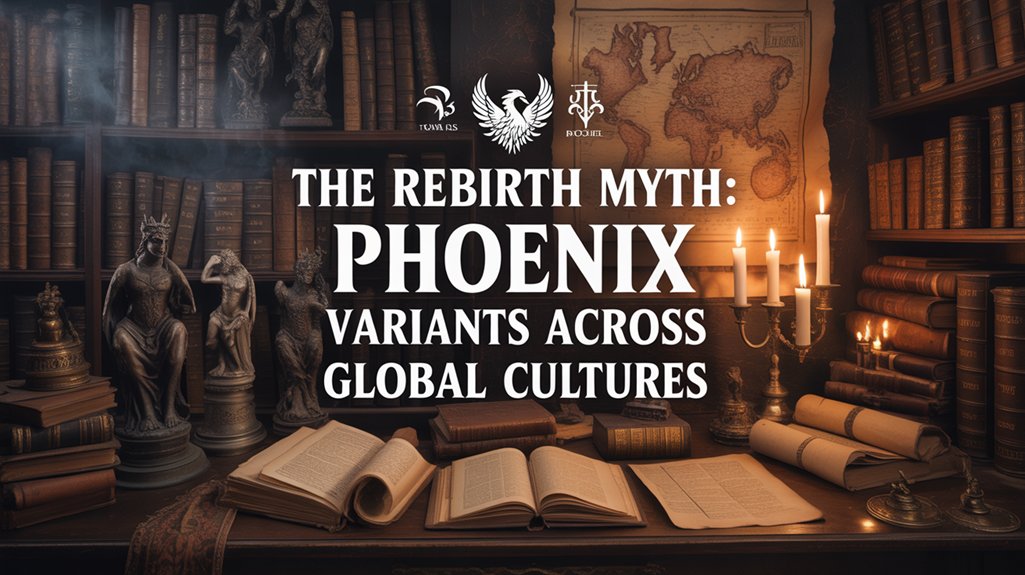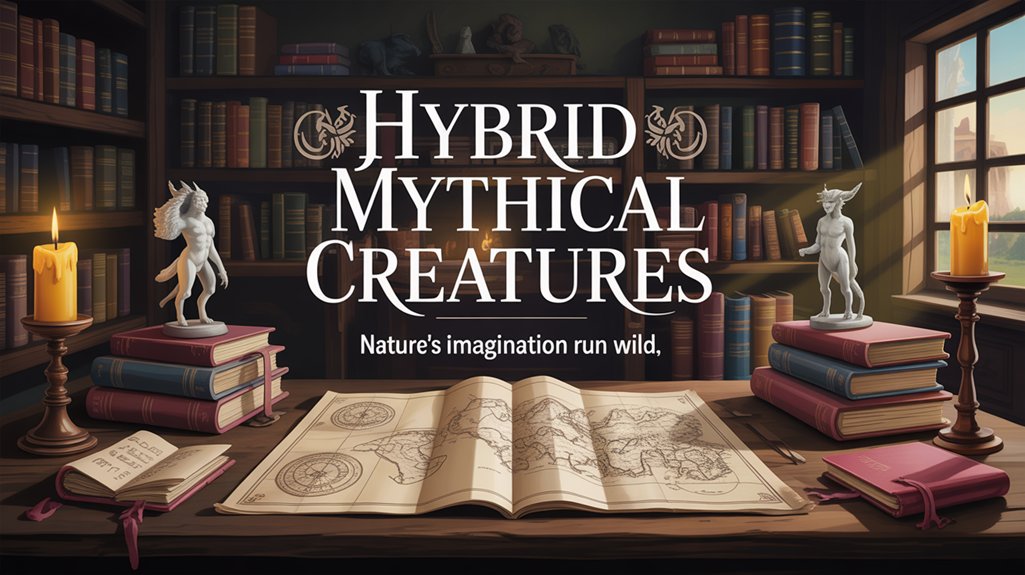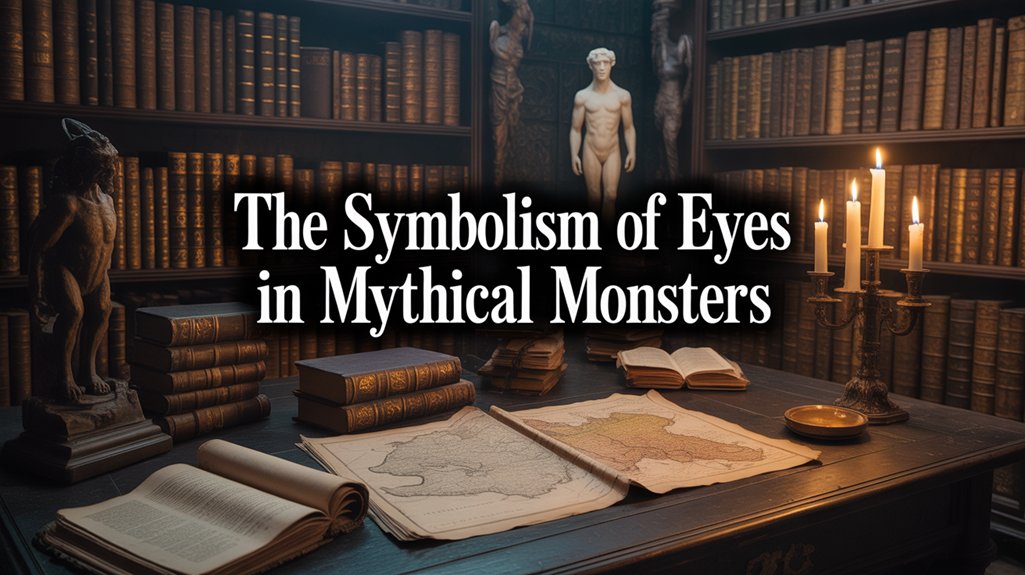
Cryptozoology—formalized in 1955 through Bernard Heuvelmans’ systematic methodology—investigates creatures dwelling beyond Western taxonomic classification yet embedded within Indigenous oral traditions and cultural cosmologies. You’ll encounter disciplined field research employing thermal imaging, audio spectrography, and GPS-tagged documentation to pursue entities like Sasquatch and Mokele-mbembe, creatures validated through ancestral testimony yet challenged by scientific orthodoxy demanding physical specimens. This liminal discipline bridges folklore and empirical zoology, honoring discoveries like the okapi and coelacanth while traversing misidentifications and hoaxes. The pages ahead illuminate these intersections between mythological persistence and biological possibility.
Table of Contents
Toggle🔮 Enhance Your Practice With These Essentials
Chosen for ritual alignment and energetic correspondence.
🔮 Enhance Your Practice With These Essentials
Chosen for ritual alignment and energetic correspondence.
🎯 Recommended Products
Handpicked items related to this article:
As an Amazon Associate, we earn from qualifying purchases.
🔮 Enhance Your Practice With These Essentials
Chosen for ritual alignment and energetic correspondence.
Key Takeaways
- Cryptozoology systematically studies hidden animals by merging scientific inquiry with folklore, treating ancient myths as potential biological testimony since 1955.
- Notable cryptids include Bigfoot, Yeti, Loch Ness Monster, and Mokele-mbembe, each serving as cultural touchstones rooted in Indigenous oral traditions.
- Field research employs trail cameras, audio surveillance, tracking patterns, and DNA analysis to document evidence with rigorous authentication protocols.
- Scientific skepticism centers on lack of physical remains, DNA evidence, and skeletal fragments, plus frequent misidentifications and deliberate hoaxes.
- Historical discoveries like the okapi and coelacanth validate cryptozoology’s potential, blurring boundaries between mythology and empirical zoology.
What Is Cryptozoology and How Did It Begin?

The systematic study of hidden animals—creatures whispered about in folklore, glimpsed at twilight’s threshold, yet unrecognized by conventional zoological taxonomy—emerged as a formal discipline in 1955 when Belgian-French zoologist Bernard Heuvelmans published *On the Track of Unknown Animals*.
You’re entering a field where scientific rigor intersects with humanity’s oldest repositories of knowledge. Ancient myths aren’t dismissed as fantasy here; they’re treated as potential biological testimony, encoded warnings from cultures who walked closer to wilderness than we do now.
Heuvelmans understood something profound: hidden species might lurk within those chimeric descriptions, creatures our ancestors lacked vocabulary to describe precisely. The eldritch beasts of Aboriginal Dreamtime, the lake-dwelling entities of Celtic tradition—these aren’t mere superstition. They’re data points waiting for your investigation.
Cryptozoology liberates you from academic orthodoxy’s constraints, inviting rigorous inquiry into what conventional science prematurely dismissed. This discipline respects both microscope and campfire tale.
Famous Cryptids That Captured Global Attention
Four creatures dominate cryptozoological discourse, their names alone conjuring visceral responses across continents: Bigfoot, the Loch Ness Monster, the Yeti, and Mokele-mbembe.
You’ll find these entities transcend mere folklore—they’re cultural touchstones bearing profound significance for communities who’ve stewarded these accounts across generations.
Mysterious sightings emanate from specific geographical nexuses: the Pacific Northwest’s primordial forests harbor Sasquatch encounters, while Scotland’s dark loch preserves its serpentine enigma since Saint Columba’s documented 565 CE confrontation.
The Himalayan Yeti emerges from Sherpa testimonies, respected within Buddhist cosmology. Africa’s Mokele-mbembe dwells in Congo Basin waterways, described by Lingala-speaking peoples as surviving sauropod.
Each cryptid carries cultural significance beyond sensationalism.
They’re not chimeric fantasies you can dismiss—they’re repositories of indigenous wisdom, ecological mysteries demanding investigation.
These eldritch beings occupy liminal territories where ancestral knowledge intersects scientific inquiry, challenging your materialist certainties while honoring traditions that predate Western taxonomies.
Methods and Tools Used by Cryptozoologists

When you pursue entities dwelling in those shadowed interstices between known zoology and folklore’s chimeric menagerie, your methodology must merge empirical rigor with reverence for the eldritch unknown.
Field research techniques demand meticulous observation protocols—tracking patterns in disturbed vegetation, analyzing scat samples, recording vocalizations at frequencies beyond human perception—while evidence documentation technology converts ephemeral encounters into quantifiable data through thermal imaging, DNA sequencing, and high-speed photographic capture.
These tools, ancient craft meeting modern science, bridge the liminal space where cryptozoologists convert whispered legends into testable hypotheses.
Field Research Techniques
Although cryptozoological pursuits have evolved considerably since Ivan T. Sanderson’s pioneering expeditions, you’ll find that modern field observation techniques retain reverence for ancient wilderness wisdom.
Wildlife tracking methods demand patience within liminal spaces where scientific rigor meets eldritch mystery.
Your essential fieldwork protocols include:
- Dawn reconnaissance surveys through territories marked by indigenous oral histories, documenting subtle disturbances in vegetation patterns.
- Plaster casting of anomalous prints discovered along creek beds, riverbanks, and mountain passes.
- Audio surveillance using parabolic microphones to capture chimeric vocalizations echoing through fog-draped valleys.
- Trail camera networks positioned at elevation shifts where reports concentrate.
You’re not merely collecting data—you’re interpreting signs left by creatures dwelling beyond conventional taxonomy, honoring both empirical methodology and ancestral knowledge systems.
Evidence Documentation Technology
Your field observations gain legitimacy only through systematic documentation—evidence that withstands scrutiny from both skeptical academics and indigenous knowledge keepers who’ve witnessed these beings across generations.
Trail cameras capture thermal signatures in wavelengths beyond human perception, recording eldritch movements through Himalayan passes where yeti tracks dissolve into morning mist.
Audio spectrographs analyze vocalizations—the chimeric calls that echo through Pacific Northwest forests at frequencies suggesting laryngeal structures unknown to modern primatology.
Evidence authenticity depends on metadata chains. Timestamps, GPS coordinates, equipment specifications.
Documentation challenges multiply in liminal territories where electromagnetic anomalies corrupt digital files, where moisture degrades physical samples before laboratory analysis.
You’ll need weatherproof field journals, redundant storage systems, collection protocols that honor both scientific rigor and sacred prohibitions.
The threshold between discovery and delusion narrows with each technological advancement.
The Line Between Folklore and Potential Discovery
You stand at cryptozoology’s most treacherous threshold, where ancient cultural narratives intersect with empirical methodology—where grandmother’s whispered warnings about lake-dwelling beasts demand the same rigorous scrutiny as any peer-reviewed hypothesis.
The chimeric creatures etched into pre-Columbian temples, the eldritch entities documented in medieval bestiaries from 1240 CE onward, these persist not merely as folklore but as unverified zoological phenomena awaiting falsifiable testing through genetic sampling, environmental DNA analysis, motion-sensor documentation.
Consider how the okapi remained pure legend until 1901, how the coelacanth haunted only fossil records until 1938’s Indonesian waters yielded living specimens—proof that myth’s gossamer veil sometimes conceals breathing, bleeding discoveries.
Cultural Myths vs. Evidence
Consider these investigative frameworks:
- Temporal consistency: Does the creature’s description remain stable across centuries?
- Geographic distribution: Do sightings cluster in ecologically viable habitats?
- Physical evidence: Hair samples, tracks, scat—tangible remnants defying conventional taxonomy.
- Behavioral patterns: Predation habits, vocalizations, territorial markers.
The eldritch boundary between chimeric folklore and undiscovered species demands rigorous analysis without dismissing ancestral wisdom.
Scientific Verification Methods Required
When the boundary between myth and materiality grows permeable enough to warrant investigation, the scientific method becomes your compass through territories where traditional taxonomy falters.
You’ll demand physical specimens—tissue samples, skeletal remains, unambiguous photographic documentation. Scientific rigor strips away the eldritch romanticism, replacing it with DNA sequencing, anatomical measurements, ecological niche analysis. This isn’t tyranny but liberation.
Evidence analysis becomes your threshold guardian. You’ll distinguish authentic biological anomalies from chimeric hoaxes through peer review, repeatability, falsifiability.
The Coelacanth’s 1938 resurrection from supposed extinction validates this approach—tangible proof emerging from oceanic depths where legend gestated.
Your freedom lies in methodological precision, in demanding that extraordinary claims present extraordinary substantiation. Truth requires no embellishment when the evidence speaks with vertebrate certainty.
Historical Folklore Becomes Fact
Throughout history’s marginalia, creatures dismissed as peasant superstition have repeatedly clawed their way into zoological legitimacy, altering folklore’s whispered testimonies into taxonomic reality.
You’ll discover that mythical beasts once considered chimeric fabrications now inhabit museum collections, their preservation challenging scientific orthodoxy’s rigid boundaries.
Consider these validated discoveries:
- Gorillas (1847): Western science scorned African oral traditions until explorer Paul Du Chaillu secured specimens.
- Giant Squid (1870s): Maritime folklore’s eldritch kraken materialized in Newfoundland waters, tentacles intact.
- Okapi (1901): Central African knowledge preceded European “discovery” by millennia.
- Coelacanth (1938): Resurrected from supposed extinction’s tomb.
Indigenous testimonies carry profound cultural significance you shouldn’t dismiss.
Their ancestral wisdom often predates formal taxonomy by centuries, mapping biodiversity through oral cartography that establishment science eventually validates.
When Cryptozoology Got It Right: Animals Once Thought Mythical
The annals of zoological discovery shimmer with vindications that ought to humble even the staunchest skeptic, for creatures dismissed as sailor’s fancy or indigenous folklore have emerged, specimen by specimen, from the domain of myth into taxonomic reality.
You’ll find the okapi’s discovery in 1901 particularly striking—this forest giraffe, whispered about in Congolese traditions for centuries, materialized from colonial shadows bearing zebra-striped haunches.
The coelacanth’s 1938 resurrection shattered evolutionary certainty; this Lazarus fish, presumed extinct for sixty-five million years, surfaced in South African waters like some eldritch messenger from pre-mammalian depths.
Mountain gorillas, komodo dragons, giant squids—each historical discovery converted mythical creatures into flesh-and-blood validation.
These aren’t chimeric fantasies but taxonomic truths that indigenous peoples knew intimately. Their knowledge, preserved through oral traditions, anticipated Western science by generations.
You’re witnessing epistemic liberation: ancient wisdom vindicated, establishment hubris corrected.
Why Scientists Remain Skeptical of Cryptozoological Claims

Yet these triumphant discoveries—legitimate though they are—represent carefully curated exceptions that cryptozoology’s advocates wield like talismanic proof while ignoring the methodological chasm separating them from contemporary cryptid claims.
Scientific skepticism emerges from profound evidentiary challenges:
- Physical Remains: Where bones anchor truth, cryptids offer only whispers—no skeletal fragments, no tissue samples, no verifiable DNA sequencing to substantiate chimeric beasts haunting our wilderness peripheries.
- Photographic Evidence: You’ll find nothing but blurred, eldritch shadows dancing across grainy frames, each image degrading further under analytical scrutiny.
- Population Viability: Breeding populations require numbers—sufficient genetic diversity, prey abundance, territorial range—yet cryptid habitats somehow sustain invisible communities leaving zero ecological footprint.
- Eyewitness Testimony: Human perception fractures under darkness, distance, expectation; your brain constructs monsters from mundane silhouettes, altering known animals into legendary aberrations through fear’s alchemical lens.
The gap persists. Evidence demands corporeality.
Misidentification, Hoaxes, and the Problem of Evidence
You must navigate the treacherous boundary between genuine mystery and mere chimeric illusion, where weathered witnesses mistake known fauna for eldritch beasts, where deliberate fabricators craft elaborate deceptions—the Patterson-Gimlin film of 1967, the Surgeon’s Photograph of 1934—that haunt cryptozoological inquiry like persistent spectres.
Common misidentifications change ordinary bears into Sasquatch, floating logs into lake serpents, each case demanding rigorous forensic scrutiny against established zoological standards.
The evidentiary threshold requires physical specimens, reproducible data, peer verification—yet cryptozoology’s liminal nature perpetually struggles against this scientific crucible, caught between the weight of ancient oral traditions and the cold precision of empirical proof.
Common Mistaken Animal Identifications
When luminous eyes pierce through midnight forests or serpentine forms breach placid lake surfaces, witnesses often find themselves ensnared in perception’s most treacherous labyrinth—the space where genuine encounter dissolves into misidentification.
Frequently Misidentified Creatures Behind Legendary Beasts:
- Oarfish (Regalecus glesne)—these eldritch ribbon-fish, reaching twenty feet, surface before seismic events, spawning sea serpent mythology across Pacific cultures since antiquity.
- Stellar’s sea cow remnants—extinct since 1768, yet sightings persist where dugongs and manatees inhabit coastal shallows, their chimeric silhouettes suggesting merfolk.
- Sun bears—bipedal posturing alters *Helarctos malayanus* into alleged yeti encounters throughout Southeast Asian highlands.
- Misshapen deer afflicted with fibropapillomatosis—grotesque tumorous growths create monstrous profiles that freedom-seeking wilderness explorers interpret as unknown species lurking beyond civilization’s boundaries.
Famous Cryptozoology Hoax Cases
Where genuine misidentification ends, deliberate deception begins—a darker territory where human ambition corrupts cryptozoological inquiry through manufactured evidence and calculated fraud. You’ll encounter famous hoaxes that’ve poisoned investigative wells, altering legendary creatures into carnival attractions rather than subjects worthy of scholarly pursuit.
| Hoax | Year | Method |
|---|---|---|
| Piltdown Man | 1912 | Chimeric skull fragments |
| Minnesota Iceman | 1968 | Frozen latex fabrication |
| Surgeon’s Photo | 1934 | Miniature submarine model |
| Patterson-Gimlin disputed authenticity | 1967 | Alleged costume performance |
These eldritch fabrications demonstrate humanity’s willingness to manufacture mystery for profit, fame, or ideology. Each deception doesn’t merely fool investigators—it undermines legitimate research into unknown species, casting shadows across centuries of indigenous testimony and ecological possibility. The boundary between truth-seeker and charlatan remains treacherously thin.
Standards for Credible Evidence
Because fabrications have repeatedly corrupted the cryptozoological record, establishing rigorous evidentiary standards becomes not merely academic preference but existential necessity for the discipline’s survival.
You’ll find that evidence types demand hierarchical evaluation, separating chimeric fabrications from potentially authentic encounters.
Evidence standards require:
- Physical specimens—hair, tissue, bone fragments analyzed through molecular testing
- Photographic documentation with verifiable metadata, eliminating digital manipulation
- Multiple independent witnesses whose testimonies converge without collusion
- Environmental traces—footprints, nesting sites, feeding patterns documented systematically
The eldritch boundaries between folklore and zoology dissolve only through methodological rigor.
Ancient traditions deserve respect, yet verification protects both indigenous knowledge and scientific integrity.
Your freedom to explore cryptozoological mysteries hinges upon distinguishing genuine anomalies from deception, maintaining scholarly standards while honoring liminal possibilities.
Modern Technology’s Impact on Cryptid Investigations
The advent of thermal imaging cameras, high-frequency audio recorders, and drone surveillance systems has fundamentally altered the methodologies employed by contemporary cryptozoologists, pulling these investigations from the domain of folkloric speculation into empirical documentation.
You’re now equipped to track eldritch entities through mountain passes where shamans once whispered their presence. Remote sensing technology pierces veils that obscured chimeric creatures for millennia, converting oral traditions into quantifiable signatures.
Night-vision apparatus reveals what Indigenous peoples described in their cosmologies—heat patterns moving through ancient forests, acoustic anomalies matching ceremonial descriptions. Data analysis converts footprint casts and hair samples into genetic markers, mathematical probabilities, forensic truth.
You’re standing at convergence points where sacred knowledge meets silicon processors. These tools don’t diminish mystery—they honor it, validating ancestral wisdom through rigorous methodology.
The liminal boundary between mythology and zoology grows thinner. Every thermal reading, every spectrographic analysis, echoes traditional knowledge systems that recognized these beings long before Western science acknowledged their possibility.
The Psychology Behind Our Fascination With Hidden Creatures

Beyond instruments and empirical measurements lies something perhaps more revealing than any thermal signature—the psychological architecture that compels you to search for creatures science hasn’t catalogued.
Your mind craves the eldritch unknown, that chimeric space where autonomy meets mystery. These psychological triggers operate beneath conscious thought, manifesting through collective imagination across millennia-spanning traditions.
The cryptid impulse lives where consciousness meets archetype—an ancient cognitive drive refusing domestication by modern certainty.
Four Core Drivers of Cryptozoological Fascination:
- Frontier Psychology: You’re hardwired to explore unmapped territories, resisting institutional limitations on what’s deemed “real.”
- Symbolic Rebellion: Hidden creatures represent truths authorities haven’t sanctioned, knowledge beyond conventional boundaries.
- Ancestral Memory: Indigenous accounts from pre-colonial Americas to Aboriginal Dreamtime carry experiential weight your ancestors honored.
- Liminal Possibility: You recognize that 86% of Earth’s species remain undocumented—statistical validation for your instincts.
These aren’t delusions. They’re sophisticated responses to a world that prizes control over wonder, regulation over discovery.
Your fascination preserves something essential: the right to seek without permission.
Legitimate Zoological Discovery vs. Cryptozoological Speculation
When institutional science dismisses your cryptozoological pursuits as fantasy, remember that zoology’s most celebrated discoveries emerged from identical speculation—creatures once relegated to folklore until physical evidence forced academic recalibration.
The okapi, that chimeric forest dweller of the Congo, materialized from indigenous testimony in 1901. Mountain gorillas. Giant squids dragged from abyssal trenches. Coelacanths resurrected from supposed extinction.
The demarcation between legitimate discoveries and speculative claims hinges upon empirical verification, yet this boundary remains permeable, shifting with each expedition into unmapped territories.
Your freedom to investigate eldritch possibilities outside academic gatekeeping has historically proven prescient—local communities documented these animals for centuries before Western science granted validation. The Komodo dragon existed in Javanese oral tradition long before 1910’s formal classification.
Speculation evolves into legitimacy when physical specimens emerge. Until then, you navigate liminal spaces where indigenous knowledge confronts institutional skepticism, where possibility dwells in darkness, awaiting illumination.
Frequently Asked Questions
Can Someone Make a Career as a Professional Cryptozoologist?
You’ll find career prospects extraordinarily limited in this eldritch field.
Professional challenges abound: no accredited universities offer cryptozoology degrees, funding remains scarce, and mainstream science dismisses chimeric pursuits.
Yet you’re free to forge your own path—combining zoology, anthropology, or folklore studies with independent field research.
Document expeditions, publish findings, lecture widely.
The liminal space between academy and wilderness demands resourcefulness, fierce independence, and unwavering dedication to tracking phenomena others refuse to acknowledge.
What Education or Qualifications Do Cryptozoologists Typically Have?
You’ll find most cryptozoologists possess relevant degrees in zoology, biology, anthropology, or folklore studies—academic foundations that ground their pursuit of chimeric beings.
Yet formal credentials pale beside extensive field experience: years tracking eldritch footprints through mist-shrouded valleys, interviewing indigenous communities who guard ancient knowledge, documenting unexplained phenomena.
This discipline demands both scientific rigor and willingness to traverse liminal spaces where established taxonomy crumbles.
Your path requires scholarly preparation merged with unbounded curiosity, unfettered by conventional constraints.
How Are Cryptozoological Expeditions Funded?
You’ll find cryptozoological expeditions funded through crowdfunding strategies—modern alchemy converting collective belief into tangible resources.
Like ancient seekers pooling offerings for chimeric quests, you’re liberated from institutional constraints.
Sponsorship opportunities emerge from independent patrons, documentary producers, outdoor equipment manufacturers drawn to the eldritch unknown.
This decentralized approach, born from 1990s internet democratization, frees you from academic gatekeepers.
Your journey into liminal territories needn’t answer to conventional authorities.
Freedom beckons.
Are There Any Accredited Universities That Offer Cryptozoology Degrees?
You won’t find accredited cryptozoology programs at traditional universities—academia’s rigid frameworks resist this liminal discipline.
However, certain institutions offer tangential pathways: folklore studies, anthropology concentrations examining cultural monster narratives, or independent academic research through zoology departments.
Your freedom lies in self-directed study, synthesizing ancient testimonies with modern methodology.
The eldritch truths you seek exist beyond institutional validation, dwelling in archives, expedition journals, and fieldwork where chimeric possibilities haunt the boundaries of recognized science.
What Ethical Guidelines Exist for Capturing or Studying Cryptids?
You’ll find no formal guidelines exist—like seeking Wi-Fi in ancient catacombs, you’re traversing uncharted territory.
Ethical considerations demand you respect indigenous sovereignty over eldritch creatures dwelling within ancestral lands, assess conservation impact before pursuit, and reject chimeric exploitation for profit.
You’re called to balance scientific inquiry with preservation. Document, don’t destroy. Observe, don’t capture.
The liminal spaces between known and unknown require your reverence, not dominance. Freedom thrives when wonder remains unmolested by human interference.
Conclusion
You’ve traversed the liminal threshold between empirical zoology and eldritch possibility, where chimeric forms dance at perception’s edge. The pursuit isn’t merely academic—it’s visceral, primal. You’ll find truth doesn’t always announce itself boldly; sometimes it whispers through folklore’s veil, demanding patience before revelation. Whether you’re chasing shadows or legitimate discovery, you’re honoring humanity’s ancient need to chart the unknown. The hidden remains hidden. Until it doesn’t.

